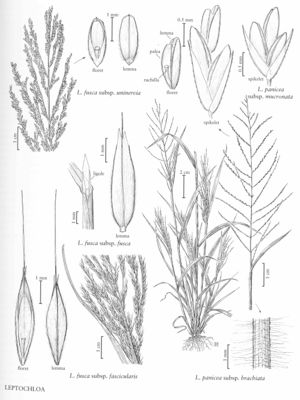Difference between revisions of "Leptochloa fusca subsp. fusca"
FNA>Volume Importer |
FNA>Volume Importer |
||
| Line 16: | Line 16: | ||
-->{{Treatment/Body | -->{{Treatment/Body | ||
| − | |discussion=<p | + | |discussion=<p>Leptochloa fusca subsp. fusca is the most variable of the subspecies. In North America, it is known only from a few specimens collected at scattered locations in California; it may no longer be in the Flora region.</p> |
|tables= | |tables= | ||
|references= | |references= | ||
| Line 32: | Line 32: | ||
|basionyms= | |basionyms= | ||
|family=Poaceae | |family=Poaceae | ||
| + | |illustrator=Linda A. Vorobik and Karen Klitz | ||
|reference=None | |reference=None | ||
|publication title= | |publication title= | ||
|publication year= | |publication year= | ||
|special status= | |special status= | ||
| − | |source xml=https:// | + | |source xml=https://bibilujan@bitbucket.org/aafc-mbb/fna-data-curation.git/src/314eb390f968962f596ae85f506b4b3db8683b1b/coarse_grained_fna_xml/V25/V25_88.xml |
|subfamily=Poaceae subfam. Chloridoideae | |subfamily=Poaceae subfam. Chloridoideae | ||
|tribe=Poaceae tribe Cynodonteae | |tribe=Poaceae tribe Cynodonteae | ||
Revision as of 16:18, 30 October 2019
Culms 40-170 cm, usually ascending to erect, some¬times decumbent and rooting at the lower nodes, often branching at the upper nodes. Blades glabrous or scabrous, not exceeding the panicles. Panicles 15-105 cm long, 2-20 cm wide, sometimes partially enclosed by the upper leaf sheaths; branches (1.5)4-20 cm, ascending to erect. Spikelets 6-14 mm. Lower glumes 1.9-3(4.9) mm, ovate, obtuse to acute, rarely bifid; upper glumes 3-4.7(5.5) mm, obtuse to acute; lemmas 3-4.7(6) mm, light brown to dark green at maturity, without a basal dark spot, apices obtuse, acute, or acuminate, sometimes bifid; anthers 3, 0.5-2.7 mm. Caryopses 1.6-2.3 mm.
Discussion
Leptochloa fusca subsp. fusca is the most variable of the subspecies. In North America, it is known only from a few specimens collected at scattered locations in California; it may no longer be in the Flora region.
Selected References
None.
